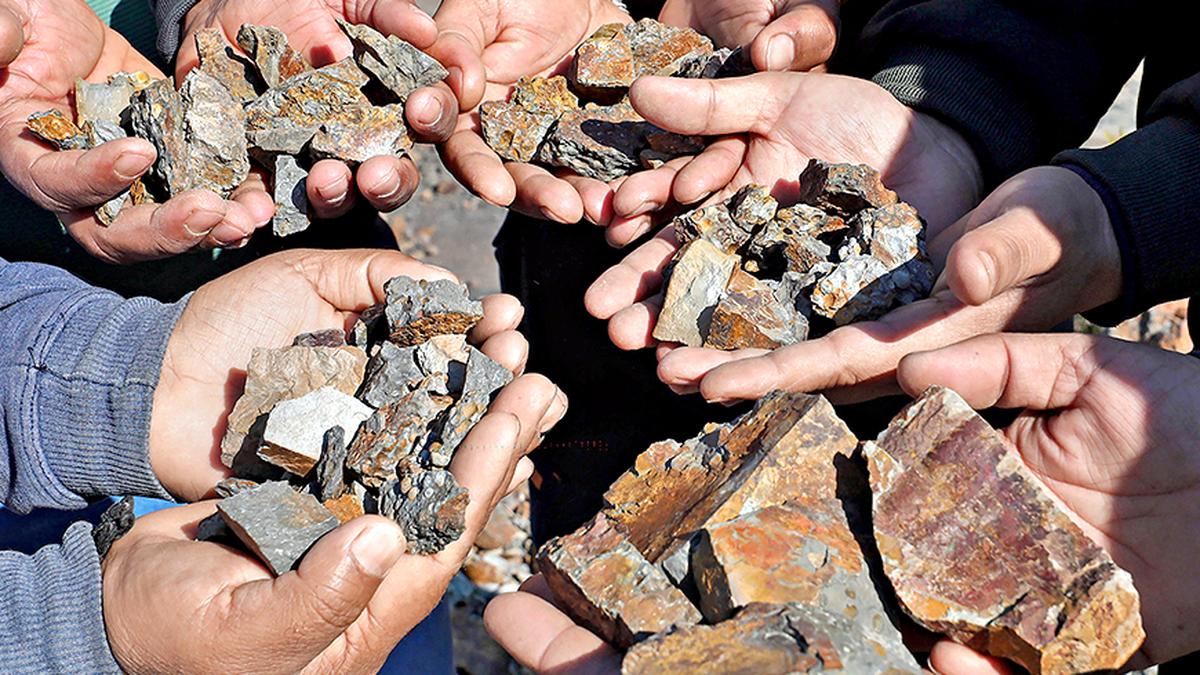India, a land of ancient civilizations and diverse landscapes, owes a significant part of its geological wealth to its origins as a fragment of the supercontinent Gondwanaland. This prehistoric connection has endowed the country with vast reserves of minerals, including coal, iron ore, bauxite, and mica, making it one of the most mineral-rich nations in the world. However, despite this geological advantage, the mining sector’s contribution to India’s Gross Domestic Product (GDP) remains modest, especially when compared to other resource-rich countries like Australia and South Africa. This paradox raises important questions: Why does India, with its rich mineral endowment, lag behind in leveraging its mining sector for economic growth? What challenges impede the sector’s development, and what can be done to unlock its full potential?
This article delves deep into the historical context, current status, challenges, government initiatives, and future prospects of India’s mining sector, aiming to provide a holistic understanding of the issue.
1. Geological Heritage: India and Gondwanaland
1.1. The Gondwanaland Connection
Gondwanaland was a supercontinent that existed from the Late Precambrian to the Jurassic period, comprising present-day South America, Africa, Antarctica, Australia, and the Indian subcontinent. Around 180 million years ago, tectonic forces began to split Gondwanaland, and the Indian plate started its northward journey, eventually colliding with the Eurasian plate to form the Himalayas.
1.2. Mineral Endowment
The geological processes associated with Gondwanaland have left India with extensive mineral resources, particularly in the Peninsular region. The following are some key mineral belts:
- The Chotanagpur Plateau (Jharkhand, Odisha, Chhattisgarh): Rich in coal, iron ore, bauxite, and mica.
- The Deccan Plateau: Hosts manganese, limestone, and copper.
- The Eastern Ghats: Known for bauxite and chromite.
- The Western Ghats: Deposits of iron ore and bauxite.
These resources have historically supported India’s industrialization and continue to be vital for its economic development.
2. Historical Evolution of Mining in India
2.1. Ancient and Medieval Periods
Mining in India dates back to the Indus Valley Civilization, with evidence of copper and gold mining. Ancient texts like the Arthashastra mention the importance of minerals and mining administration.
2.2. Colonial Era
The British colonial administration exploited India’s mineral wealth to fuel their industries. Railways were built to transport coal and iron ore, and the sector saw the establishment of major mines in Jharia, Raniganj, and Kolar.
2.3. Post-Independence Developments
After independence, the government nationalized key mineral sectors (coal, oil, and steel), established public sector enterprises, and enacted laws such as the Mines and Minerals (Development and Regulation) Act, 1957. The sector expanded rapidly, but inefficiencies and lack of modernization became apparent over time.
3. Current Status of the Mining Sector
3.1. Contribution to GDP
Despite its vast resources, the mining sector’s share in India’s GDP has remained between 1.75% and 2.5% over the past two decades. In contrast, countries like Australia and South Africa derive 7–10% and 8% of their GDP, respectively, from mining.
3.2. Production and Exports
India is among the top producers of several minerals:
- Coal: 5th largest producer globally.
- Iron Ore: 4th largest producer.
- Bauxite: 7th largest producer.
- Mica: Once the world’s largest producer.
However, the focus is largely on raw mineral exports, with limited value addition. For example, India exports significant quantities of iron ore but imports finished steel.
3.3. Regional Disparities
Production is concentrated in a few states:
- Odisha: 44.9% of national mineral output.
- Rajasthan: 15.5%.
- Chhattisgarh: 13.9%.
States like Goa, once major contributors, have seen their share decline due to regulatory bans and environmental concerns.
4. Challenges Facing the Mining Sector
Despite its potential, several interrelated challenges have constrained the mining sector’s growth:
4.1. Regulatory and Environmental Bottlenecks
4.1.1. Lengthy Approval Processes
Obtaining environmental clearances, forest clearances, and land acquisition approvals can take several years. The process involves multiple agencies and is often marred by bureaucratic delays.
4.1.2. Stringent Environmental Regulations
While necessary for sustainability, stringent regulations have sometimes led to blanket bans, as seen in Goa and Karnataka. These measures, though well-intentioned, have disrupted mining activities and affected livelihoods.
4.2. Infrastructure Deficiencies
4.2.1. Transport and Logistics
Most mineral-rich regions lack adequate rail, road, and port infrastructure. This increases transportation costs and reduces the competitiveness of Indian minerals in global markets.
4.2.2. Processing Facilities
Limited mineral processing and beneficiation facilities mean that much of the value addition happens outside India, resulting in lower revenues and employment.
4.3. Investment and Technological Lag
4.3.1. Low Investment
The sector attracts limited foreign and domestic investment due to perceived risks, regulatory uncertainty, and long gestation periods.
4.3.2. Outdated Technology
Many mines still use manual or semi-mechanized methods, leading to low productivity. For example, coal mining productivity in India is significantly lower than in Australia or the US.
4.4. Social and Tribal Issues
4.4.1. Land Acquisition and Displacement
A significant portion of India’s mineral wealth lies in areas inhabited by tribal communities. Mining often leads to displacement, inadequate rehabilitation, and social unrest.
4.4.2. Livelihood Concerns
Mining can disrupt traditional livelihoods such as agriculture and forestry, leading to resistance from local communities.
4.5. Illegal Mining and Corruption
Illegal mining, especially of sand, iron ore, and coal, is rampant in several states. It leads to revenue losses, environmental degradation, and undermines the rule of law.
5. Government Initiatives and Reforms
Recognizing these challenges, the government has undertaken several reforms to revitalize the sector:
5.1. Policy Reforms
5.1.1. National Mineral Policy 2019
The policy aims to increase the sector’s GDP contribution to 2.5% by 2026–27. It emphasizes transparency, sustainability, and private sector participation.
5.1.2. Mines and Minerals (Development and Regulation) Amendment Act, 2015 & 2021
These amendments introduced auction-based allocation of mineral blocks, removed end-use restrictions, and allowed the transfer of mining leases, making the sector more attractive to investors.
5.2. Ease of Doing Business
5.2.1. Single-Window Clearance
Several states have introduced single-window clearance systems to streamline approvals.
5.2.2. Digitization
Online portals for license applications, monitoring, and compliance have reduced paperwork and increased transparency.
5.3. Infrastructure and Technology
5.3.1. Dedicated Freight Corridors
Projects like the Eastern and Western Dedicated Freight Corridors aim to improve mineral transport efficiency.
5.3.2. Promotion of R&D
Incentives for research in mineral beneficiation, exploration, and sustainable mining practices have been introduced.
5.4. Social and Environmental Safeguards
5.4.1. District Mineral Foundation (DMF)
DMFs have been set up to ensure that a portion of mining revenues is used for the development of mining-affected areas, especially for the welfare of tribal communities.
5.4.2. Environmental Management
Stricter norms for mine closure, reclamation, and afforestation have been implemented to mitigate environmental impacts.
6. Comparative Analysis: India vs. Australia and South Africa
6.1. Policy and Regulatory Environment
Australia and South Africa have streamlined regulatory frameworks, clear land acquisition processes, and stable policy environments, making them attractive destinations for mining investment.
6.2. Technology and Productivity
Both countries have invested heavily in automation, remote sensing, and advanced exploration techniques, resulting in higher productivity and lower costs.
6.3. Value Addition
Australia and South Africa focus on value addition, exporting processed minerals and finished products, whereas India largely exports raw minerals.
6.4. Community Engagement
Effective community engagement and benefit-sharing mechanisms have reduced social conflicts in these countries, unlike in India, where mining often leads to displacement and unrest.
7. Case Studies
7.1. Odisha: A Success Story
Odisha is India’s mining powerhouse, contributing nearly half of the country’s mineral output. The state has benefited from policy reforms, improved infrastructure, and proactive governance. The introduction of auction-based allocation and DMF funds has led to increased revenues and community development.
7.2. Goa: The Perils of Overexploitation
Goa’s iron ore mining boom led to environmental degradation, illegal mining, and conflicts with local communities. The Supreme Court’s mining ban in 2012 and subsequent restrictions highlighted the need for sustainable mining practices and robust regulatory oversight.
7.3. Jharkhand: Tribal Rights and Mining
Jharkhand, rich in coal and iron ore, has witnessed frequent conflicts between mining companies and tribal communities. Issues of displacement, inadequate compensation, and loss of livelihoods have fueled resistance, resulting in project delays and legal battles.
8. The Way Forward: Unlocking India’s Mining Potential
To realize the full potential of its Gondwanaland legacy, India must address the structural bottlenecks facing its mining sector. The following strategies are recommended:
8.1. Regulatory Reforms
- Simplify and streamline approval processes by integrating environmental, forest, and land clearances into a single-window system.
- Ensure policy stability to attract long-term investment.
8.2. Infrastructure Development
- Invest in rail, road, and port infrastructure in mineral-rich regions.
- Promote mineral processing and beneficiation to enhance value addition and create jobs.
8.3. Technological Upgradation
- Adopt advanced exploration and mining technologies such as remote sensing, GIS, and automation.
- Encourage research and development through public-private partnerships.
8.4. Social and Environmental Responsibility
- Strengthen community engagement and ensure fair compensation and rehabilitation for displaced communities.
- Promote sustainable mining practices to minimize environmental impacts.
8.5. Curb Illegal Mining
- Enhance surveillance and enforcement through technology (e.g., satellite monitoring).
- Promote transparency in mineral allocation and revenue sharing.
8.6. Focus on Critical Minerals
- Diversify the mineral portfolio by exploring and developing critical minerals such as lithium, cobalt, and rare earth elements, which are vital for the green economy.
9. Conclusion
India’s geological inheritance as part of Gondwanaland has provided it with immense mineral wealth. However, a combination of regulatory hurdles, infrastructural gaps, technological lag, and social challenges has prevented the mining sector from realizing its full potential. While recent reforms and policy initiatives are steps in the right direction, much remains to be done.
Unlocking the true value of India’s mineral resources requires a holistic approach—one that balances economic growth with environmental sustainability and social justice. By learning from global best practices and addressing its unique challenges, India can transform its mining sector into a key driver of economic growth, job creation, and regional development, fulfilling the promise of its Gondwanaland legacy.





0 Comments